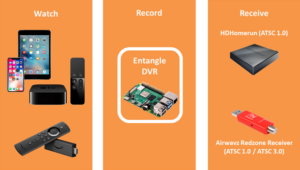It’s been a while since we’ve posted and we’ve got some exciting news – we’re pleased to add the Raspberry Pi 4 to the Entangle family!


The inner workings of Koherence, LLC
It’s been a while since we’ve posted and we’ve got some exciting news – we’re pleased to add the Raspberry Pi 4 to the Entangle family!

Project Entangle, Koherence’s OTA platform, hit a milestone over this weekend: it’s archive passed 100,000 hours of (unique) recorded OTA shows!

Those of you who’ve followed us here at in-koherence know that we’ve taken a skeptical eye to using SSDs in DVRs, although things started to turn around a couple years ago. Still, even with improved endurance and falling prices the good old hard drive reigned supreme. While they eventually suffer mechanical failure (usually degradation of the platters) after a time, they tend not to fail just because you’ve written a certain amount of data to them. In regular use the drive will suffer mechanical failure long before then. This isn’t the case with SSDs. The NAND flash cells can only be written a given number of times, and although most employ sophisticated algorithms to optimize the wear of those flash cells, you need to pay attention to a drive’s endurance rating.
But something interesting has happened in the storage market – high endurance and somewhat affordable SSDs have started to appear – thanks to the chia cryptocurrency of all things. And a reasonably-priced high-endurance SSD is just what’s needed for DVRs.
Continue reading “DVR Storage Revisited: Chia Plotting SSD Drives”

Broadcast television has traditionally been a prix fixe affair. A bunch of people shoot some video, slice it, stich it, and present it to you on your large screen TV to sit back and savor. If what appears doesn’t suit your palette, well, you can change the channel. Traditional broadcast TV has also been a largely lean back, consumptive experience without any chance to interact with or steer the program.
All that could change with ATSC 3.0 (aka NextGen TV). Continue reading “Reach Out and Touch Someone (…or your TV). Thoughts on ATSC 3.0 broadcast apps.”

MOUNTAIN VIEW, California (AB) Koherence Labs, the R&D arm of consumer electronics consulting firm Koherence, LLC, is rumored to have made a breakthrough in content recording. Dubbed “InfiniDVR,” the new technology allows an effectively unlimited recording capacity and permits viewing of all shows that have ever been or will be broadcast.
Continue reading “Breakthrough in DVR Storage and Time Shifting Rumored”